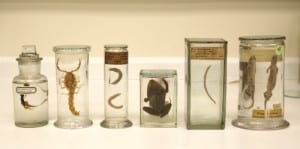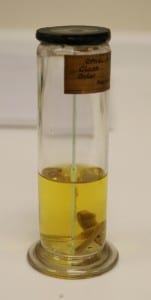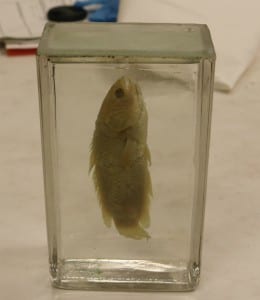Project Pickle – Conserving our Specimens Preserved in Fluid
By Emilia L Kingham, on 1 August 2016
Over the past year, UCL Museums’ conservation team have been focussing our efforts on the the specimens preserved in fluid at the Grant Museum. We’re calling it Project Pickle*.
Before we could start conserving the objects we had to establish the scale of the task, so we could decide how to plan the work. We went through the entire fluid specimen store, surveying a whopping 3,787 specimens to determine what treatments each of them needed.
This initial phase took many months to complete and involved the help of student volunteers and a student placement. The result of that survey means that we can now quantify how many specimens are in good, fair, poor or unacceptable condition with the aim to prioritize conserving the specimens in the worst condition. So why do fluid preserved specimens need conservation and how do they get to be in an ‘unacceptable condition?’
Keeping our spirits up
Our specimens have been preserved in a variety of fluids over the centuries. However, one of the most common preservatives is alcohol. In concentrations of 70%-80% alcohol, the fluid keeps the specimen from decomposing and will even allow for DNA extraction. Issues arise because alcohol evaporates very quickly when exposed to air and very often the seals on the specimen jar lids are not air-tight. If this is the case, as the alcohol evaporates, the concentration of alcohol in the fluid will decrease (alcohol evaporates more readily than the water it is in solution with). Alcohol concentrations lower than 65% can encourage mould growth on the specimen and can cause the specimen to start to decompose. If the alcohol evaporates fully then the specimen will dry out, potentially damaging the specimen for future use. All of these situations are certainly not ideal for our collections! More can be read on fluid specimen conservation here.
Dry “wet” specimens
With the help of freelance conservator Lucie Graham, this year we are working through conserving all the fluid specimens that were assigned a condition category of ‘poor’ and ‘unacceptable’. These categories represent specimens that are in dire need of conservation or else they will potentially be unsavable. Very often this means that the fluid in the jar has nearly evaporated or the specimen has already started to grow mould. Because the evaporation of alcohol can cause disastrous effects for fluid preserved specimens, it is very important to maintain a regular regime of checking and topping up the fluid levels in the collections.
Topping up
In order to top up or change the fluid in a jar, we first need to know the current alcohol concentration of the fluid. We do this by taking a small sample from the jar and testing it with a digital density meter for fluid. Once we know the alcohol concentration, we can then calculate the appropriate concentration of new fluid to add to the jar in order to achieve 80% alcohol.
Rehydrating
If the alcohol is nearly evaporated, then we need to put the specimen slowly through stages of 20% to 80% alcohol. If we were to put it straight back into a high alcohol concentration it could damage the specimen, as the change would come as too much of a “shock” – we have to slowly increase the strength of the solution.
Once the alcohol concentrations are correct, the jar lids are sealed properly and the specimens should remain happy in their jars for many years. This work is scheduled to continue into 2017. We’ll be posting pictures of our progress over the the Grant Museum’s Twitter account.
*We appreciate that not everyone likes the term “Pickle” for specimens preserved in fluid, but that’s been discussed elsewhere on this blog.
Emilia Kingham is a Conservator in UCL Museums
2 Responses to “Project Pickle – Conserving our Specimens Preserved in Fluid”
- 1
-
2
The Grossest (Coolest) Things in the Grant | UCL Researchers in Museums wrote on 23 June 2017:

[…] in the Museum require a lot of care. Currently the Grant is undergoing a long term project, called Project Pickle, to conserve the wet specimens in need of a top up. But, until this specimen’s jar is topped up […]
 Close
Close







[…] the Grant Museum’s specimens which are preserved in fluid (read more about ‘Project Pickle’ here). During the ongoing work, specimens have been re-hydrated, remounted, rehoused and […]